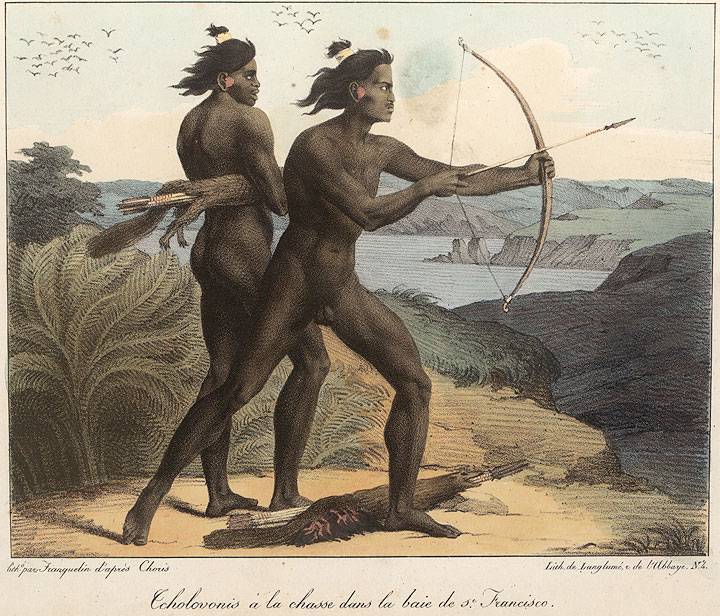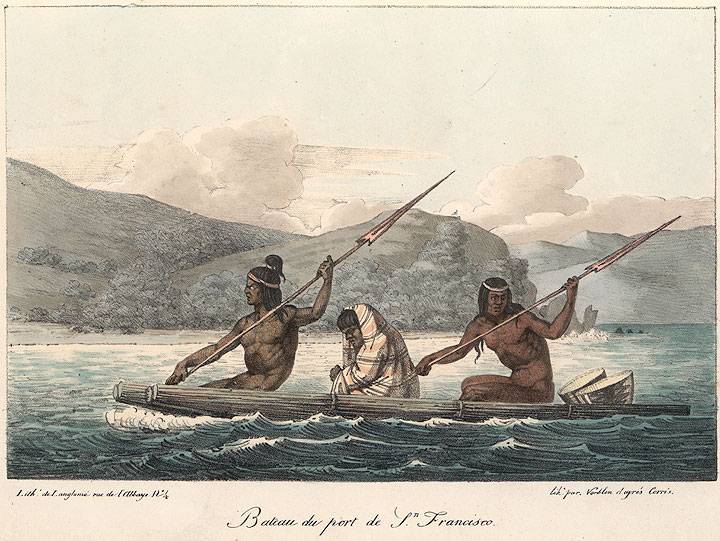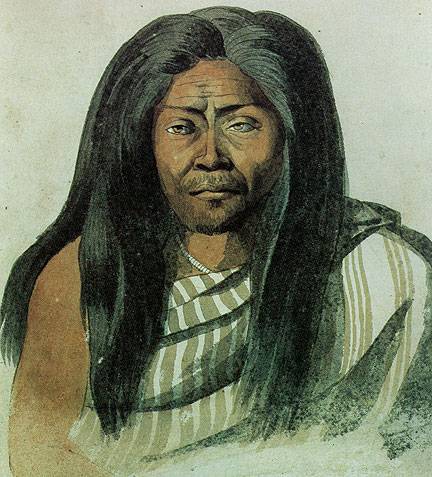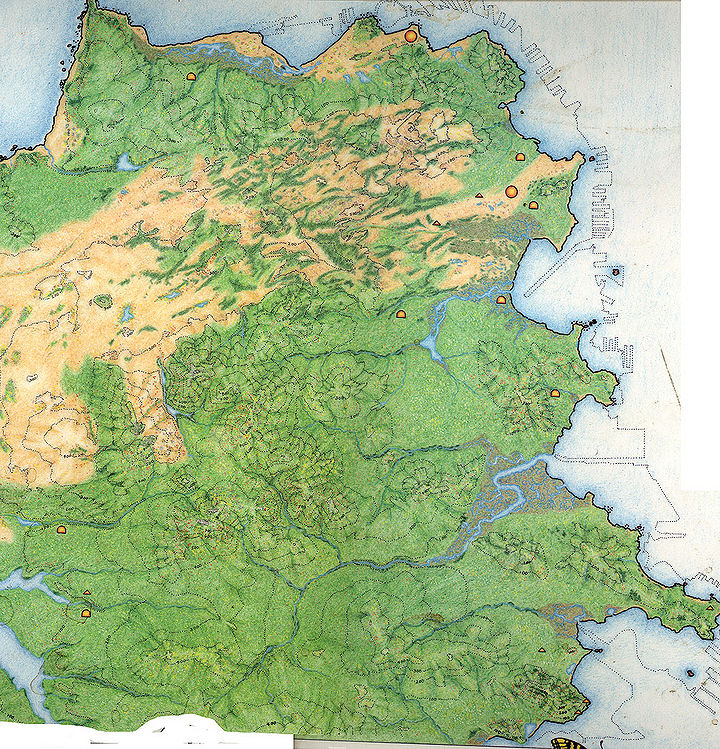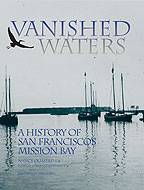Water on the Land—The Coast People
Historical Essay
by Nancy J. Olmsted
About 15,000 years ago the level of the sea began to rise, and over the next 10,000 years ocean waters gradually drowned the great inland valley of an ancient river that had carved the deep canyon of the Golden Gate with the sands of the Sierra, that had been carried in snowmelt to the sea. The ancient river canyon was cut more than 10,000 years ago when the sea was more than 300 feet below its present level and the coastline was west of the Farallon Islands.3 The ocean did not spill through the Golden Gate all at once with a great shaking of the earth, as the Indians recounted, but filled in slowly as the great glaciers of the last ice age melted, raising the sea level. Filling first the deepest canyons of the great river, the sea rose until it reached a point 381 feet above the river’s bedrock at the Golden Gate.
Bowstrings were made of sinew or vegetable fibers. Louis Choris, 1816. Arrows were tipped with chipped stone or bone arrowheads and the shanks had feathers attached with asphaltum. Quivers for the arrows appear to be fox skins in this view. These San Francisco Bay Indians are not drawn as a European would have imagined them to be, but are close representations. On this same voyage, Choris made careful drawings of Pacific Islanders and Eskimos. His detailed renderings of their artifacts are so correct from an anthropological viewpoint that we can have confidence that his watercolors and lithographs of the Coast People are equally accurate.
Image: Bancroft Library (brk00001577_24a)
The tidal lagoon of Mission Bay was created late in this period of rising sea, which reached its present height about 5,000 years ago. A contoured underwater ridge, 200 feet above the floor of the bay, extends south from Rincon Hill (near the western footing of the San Francisco Bay Bridge) to Mission Rock at the outer edge of Mission Bay. It then curves northeast to include Yerba Buena Island, channeling water to the east.4 This relatively recent event was not the first time the ocean flooded the floor of the bay-the presence of seawater has been traced back 125,000 years. Beneath the layers of mud and peat sediments that underlie Mission Bay there may be another far more ancient alluvium floor. After the last ice-melt raised the ocean level, Mission Bay extended over at least 560 acres of tidal mudflat. By the time of the Coast Survey Map of 1852, the silt deposited by the tides had transformed the 300 acres above normal high-water into salt marsh, leaving 260 acres of shallow lagoon covered by a foot or more of water at low tide.
The 260 acres of shallow seawater spread out to receive the sun like a great floating greenhouse. As microscopic diatoms, eel grass and other plant life photosynthesized the sun’s energy, generations of underwater vegetation grew superabundant grazing grounds for such herbivores as sea snails. Unconsumed plants decayed into the mud, feeding microscopic bacteria. If not swept out by the tides, the residues formed layers of peat on the bottom. Twice a day seawater swept in waves of tiny crustaceans to nourish the millions of mussels and other filter feeders that burrowed in the rich ooze, awaiting the tidal surge.
The incoming tides carried sediments from the engulfed river and the ocean. Mud and sand built up along the edges of the lagoon, forming islands that sprouted cordgrass and, at the higher levels, pickleweed. The lagoon began evolving into a salt marsh, the most energy-productive source of life of all natural habitats. As salt marshes do, it gave more to the world’s ecosystem than it received.5
Except for the occasional winter storm, blowing in from the southeast, Mission Bay remained a lagoon and marshland of calm, protected sunny water. With such a setting it became the banquet ground for an enormous bird population, both the year-round residents, such as the phenomenal duck community, and the migrating birds, among them the Canada geese and visiting loons. “The smelt turned the water silver,” attracting egrets, herons, osprey and gulls.7 Hawks, owls and falcons fed on multitudes of mice, shrews and rabbits in the upper reaches of the salt marsh.
The variety of the landscape at Mission Bay added to the abundance and diversity of plant and animal life, as a winding, fresh-water stream joined the salt marsh from the west. One of many small streams that originated in Twin Peaks, Mission Creek first appeared as a small waterfall that fed a seasonal pond fringed with willows and then made its way into the tidal estuary of Mission Bay. (Within historic times the site of the freshwater wetlands underlay what is now Seventeenth to Nineteenth streets at Valencia; Mission Creek joined the tidal arm of Mission Bay at Sixteenth Street).8
The Coming of the Coast People
Into this landscape that was more water than dry land, the coast people came, skimming over the shallow water of Mission Bay in their balsas, the bouyant watercraft made of tule reeds lashed together in bundles. With pointed sticks they pried mussels from rocks and dug up clams; with woven baskets they scooped up smelt; with throwing nets weighted by grooved stones, they snared ducks and shorebirds. Independent of the tides, they could paddle up Mission Creek to cut willow withes for their baskets and for lashings to hold the pole framework of their huts. In the brackish back water along the creek, they harvested the tule reeds that gave them new boats, fibers for their sleeping mats and aprons, and thatch for their conical houses. Beside fresh-water springs they set up their encampments, living lightly on the land until the season changed or their food supply was exhausted and they had to move on within their tribal territory.
Earliest European view of the Coast People. Unique among California Indians, the double-bladed paddle was a special innovation of the coast people. With its pointed prow the buoyant balsa could carry four people, swiftly and easily, into inlets and coves, from island to island in the bay. The Spanish invention in this view is the woven, striped blanket, made by the woman neophytes at the mission. This is the earliest view we have of the Coast People, made in 1816 by Louis Choris, a world traveler of acute perception who wrote, “I have never seen one laugh. I have never seen one look one in the face. They look as though they are interested in nothing.” By 1816, this was true.6
Image: Bancroft Library (brk00001587_24a)
It is uncertain when the wandering coast people first appeared on Mission Bay. Burial mounds with artifacts and middens dating back to an estimated 3,500 BC were found on Hunters Point, some near the shore at Candlestick Park.9 The people of these mounds may have been the ancestors of the Costanoans, as the Spanish named the coast people. The Costanoan linguistic group, comprised of eight separate languages spoken by 50 autonomous tribes (each with its own dialect), has been traced to 500 A.D. At the time the Spanish arrived the coast people had fished the waters of Mission Bay for 1,275 years. They numbered 10,000, all in the same linguistic group, of which 1,400 are thought to have spoken Ramaytush—the language spoken by the group most closely associated with Mission Bay.10
The Coast People, Half Revealed
We do not know the name they called themselves. “Costanoan” has been the useful descriptive category for the people who belonged to this large linguistic group and lived on San Francisco Peninsula as far south as Monterey on the ocean side. Indians living in the Bay Area today reject “Costanoan” because it is Spanish; they prefer “Ohlone,” meaning “the abalone people,” which is closer to their own conception of their ancestors’ identity.11 Studies of basket fragments and materials found in middens, descriptions of the tribes’ physical and social life set down by the Spanish Fathers and visiting explorers (mostly in the early 19th century), plus the threads of memory recorded in ethnographers’ field notes of the early 20th century—these form the basis for all later accounts of the coast people. The fundamental agreement of these sources, as late as many of them are, is the basis for what follows.
An Ohlone Indian as drawn by Louis Choris in 1816.
Image: Oakland Museum of California
The Coast People on Mission Bay
That the coast people had an encampment at Mission Bay seems certain. The seasonal pond edged with willows, and Mission Creek leading directly to the sheltered feeding ground for thousands of birds, made the sunny bay the perfect setting for a people whose choice of food was mussels. Whether their settlement was large or small, temporary or permanent, we cannot say.
Tribelets ranged from 50 to 500 members; the average village had about 200 people. Larger groups were more likely to have a permanent central village with outlying, temporary camps placed near specific food sources. The absence of oaks at Mission Bay, in a culture where acorns were used every day as a staple food in the form of gruel or small cakes, suggests that Mission Bay was one of several temporary encampments visited periodically from a permanent village further inland.
One of the puzzles about California Indians is the fact that the languages of the tribes differed so greatly, even within the same linguistic group. Captain Juan Bautista de Anza, for example, brought an Indian from Monterey to San Francisco to serve as interpreter, but even though he was a Costanoan he could not understand Indians in the Bay Area. Anza also discovered that his Indian guides were afraid to cross specific physical boundaries; a certain territory was allotted to each tribe, and boundaries were respected.12
San Francisco before European arrival. Yellow circles represent villages, half circles and triangles represent seasonal camps and artifacts.
Poster by Nancy Morita, sponsored by Planet Drum Foundation
Whatever the reasons for this multiplicity of small, isolated tribes, one result was to spread the Indian population out over the land. Food supplies were not over-used, so each tribe could count on having enough roots, berries, seeds and acorns. The Indians developed a sophisticated method for making sure crops of clover and other annuals were abundant; they set fire to certain grasslands every year, which assured them of a fast second crop with plenty of seeds and bounteous grazing for the deer they hunted. But beyond this practice they planted no crops; they depended instead on the natural course of the seasons to bring them berries, acorns, amole plant, wild onions and the roots of lilies. One indication of the coast people’s self-sufficiency is that although they supplied inland Yokut Indians with salt, mussels, abalone shells and dried abalone meat, their only import was pinon pine nuts. So abundant was the wildlife near Mission Bay that quail could be killed by throwing stones, rabbits caught by hand and fish scooped up by the basketful.
Baskets for gathering, cooking and storage were essential to the coast people’s existence. The bracken fern, sedges, rushes, tule and willow were woven into a wide variety of shapes and sizes. They decorated these twined baskets with olivella-shell beads, quail feathers, abalone pendants and woodpecker crests of red feathers. Not only did they decorate their baskets, they painted themselves with hematite, cinnabar and white clay, and wore necklaces of shell beads.13
The coast people played music on flutes fashioned from hollowed alder branches, whistles made from hollow bird bones and rattles made with cocoons. They decorated their bodies for the dances and music that were their ceremonial celebrations. Their dances went on for hours. Sometimes just the men danced, other dances were performed by the medicine men, still others were reserved for women. Among their traditional dances were the coyote dance, the dove dance and the bear dance. Dancing sometimes seemed to produce a state of self-hypnosis in which the coast people were seen to swallow live embers.14 The religion of the tribes was a mixture of witchcraft and their belief in magic, myths and the importance of their dreams. All of this would have made them particularly vulnerable to the Spanish missionaries. Mission music and ritual chanting at high mass had great fascination for the neophytes. The importance their own ceremonies had for the Indians was matched by the great significance religion held for the Spanish Fathers.
This is chapter one of "Vanished Waters: A History of San Francisco's Mission Bay" published by the Mission Creek Conservancy, and republished here with their permission.
NOTES
1. San Francisco’s rowing clubs used the sunny expanse of Mission Bay and Long Bridge from the 1860s right up through the turn of the century. The clubhouses of the Ariel and South End rowing clubs were moved to Aquatic Park in San Francisco in the 1930s.
2. James Roxburgh was the historian for the South of Market Journal during the 1920s and ‘30s. His recollections match the city directory addresses from 1875 through 1880. A man of many south-of-Market trades, he was a frequent toast-master at picnics and banquets, holding forth on the good old days of his boyhood on the south waterfront. Bound copies of a complete run of the South of Market Journal may be found in the California History Room of the San Francisco Public Library.
3. Salem Rice, geologist, comments “When San Francisco’s ancient river canyon was cut, 15,000 to 20,000 years ago, the sea level was more than 300 feet below its present level and the coastline was on the far side of the Farallon Islands.” George D. Louderback, Geologic Guidebook of San Francisco Bay Counties, Bulletin 154 (San Francisco: Division of Mines, 1951), 85.
4. “On the average, sea-level in the vicinity of San Francisco Bay rose about 2 cm/yr from 9,500 to 8,000 years ago, but it has risen only 0.1-0.2 cm/yr from 6,000 years go to the present. . . . The rising sea entered the Golden Gate 10,000-11,000 years ago. . . an estuary then spread rapidly, advancing about 30 m/yr along the course of the trunk stream draining the site of southern San Francisco Bay and reaching the vicinity of Menlo Park by 8,000 years ago. . . Most of the bayward growth of marshes has occurred during the past several thousand years as evidenced by lower intertidal and subtidal deposits which typically lie no more than a few meters below mean sea level, beneath historic salt marshes.” Brian F. Atwater, Charles W. Hedel, and Edward J. Helley, Late Quaternary Depositional History, Holocene Sealevel Changes, and Vertical Crustal Movement, Southern San Francisco Bay, California, Geological Professional Paper 1014 (Washington, D. c.: United States Government Printing Office, 1977), 1112; Louderback (from Hoover-Young Bay Bridge Committee Report), 7-8.
5. Michael G. Barbour and Robert Craig, Frank R. Drysdale and Michael Ghiseline, Coastal Ecology: Bodega Head (Berkeley: University of California Press, 1973), 157ff.
6. Louis Choris, Voyage Pittoresque du Monde (Paris: Firmin Didot, 1822).
7. James Roxburg, South of Market Journal (October, 1926).
8. H.H. Bancroft, History of California, 7 vol. (San Francisco History Company, 1884-1890), vol. 1:293-294, footnote.
9. Roger R Olmsted and Nancy Olmsted, Research Design to Locate Nelson Shell Mounds (San Francisco: San Francisco Clean Water Program, 1981).
10. Richard Levy, “Costanoan,” Handbook of North American Indians (Washington, D.C.: Smithsonian Institute, 1978), 485.
11. F.W. Beechey spoke of the “Alchone” and the “Olchone” in 1826, placing them as a tribelet living on the seacoast between Monterey and San Francisco. Their harvest of abalone would have been prodigious on this stretch of coast. Levy, p. 494; Malcolm Margolin, The Ohlone Wa'y (Berkeley: Heyday Press, 1978), 34.
12. Fray Francisco Palou Account of the Founding of San Francisco, edited by H.E. Bolton (Berkeley: University of California Press, 1930), vol. 3:129.
13. Levy, “Costanoan,” 493.

